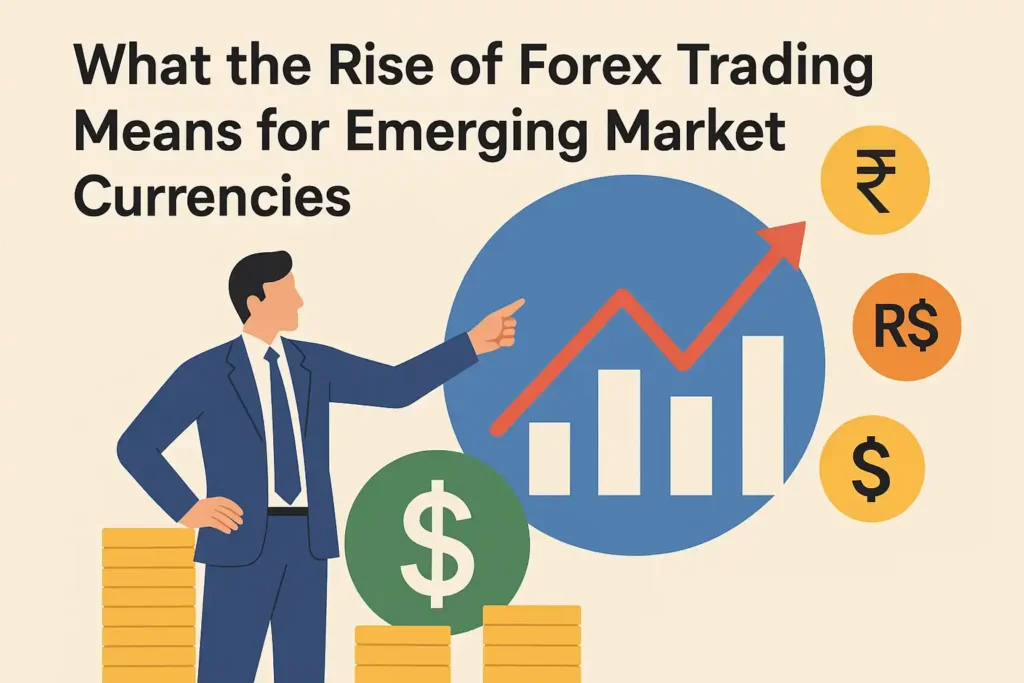The rapid growth of forex trading in recent years has changed how money moves across borders. For emerging market currencies, this shift has been both empowering and unpredictable, bringing more liquidity and opportunity while exposing them to new risks.
Emerging market currencies have greater global trading opportunities and range in value from the rupee in India to the real in Brazil and the rupiah in Indonesia. These currencies can be traded in various foreign exchanges, which has made them more useful in global transactions, and international trade has increased.
Global Forex Trading Growth in 2025
The foreign exchange market is the largest financial marketplace in the world. Data from the Bank for International Settlements (BIS) shows that as of April 2022, the daily forex turnover was around 7.5 trillion dollars, a considerable rise from 6.6 trillion dollars in 2019.
The BIS also notes a steady rise in participation from non-dealer financial institutions, showing how trading has spread beyond large banks and hedge funds. Easier digital access has been key to that growth. Across Asia, a younger and more tech-driven generation has embraced forex trading through mobile platforms and online tools.
Educational resources and market analysis tools that allow for real-time analysis for both retail and professional users have made trading more transparent and trading instructions more educational. This has also contributed to a significant increase in investors from developing countries becoming more engaged in the contemporary global forex market.
The Increasing Importance of Emerging Market Currencies
There is a notable increase in the share of global forex activity attributed to emerging market currencies. The Indian rupee, Chinese yuan, Brazilian real, and South African rand are becoming more frequently used in international transactions.
In early 2025, around 2.1% of all allocated global reserves were in the Chinese renminbi, according to the IMF COFER data. Meanwhile, the US dollar and euro continue to dominate global reserves. Most emerging market currencies are included in the “other currencies” section. While this does include advanced economies such as Australia and Canada, emerging market currencies are increasingly becoming staples of global reserves.
Three main factors are driving this trend. For one, developing economies are growing at a higher rate, which improves the perception of the economy. In addition, regional trade partnerships are reducing the reliance on the dollar in cross-border trade. Finally, gateways for all dimensions of trade, such as the forex market, the internet, and digital technology, are far more accessible to individuals and institutions.
Such currencies are being incorporated into global trade, making them more susceptible to major market movements such as interest rates, commodity prices, and overall market sentiment.
Opportunities and Risks for Emerging Economies
Market sentiment and other macroeconomic variables help to determine when and to what extent the demands of global investors will be met on emerging currencies. The rise in forex trading will increase liquidity in developing market economies and help to align their economies with real market valuations. Central banks of developing countries will gain increasingly valuable insight into the behavior of global investors as forex trading increases in their economies.
Volatility increases due to rapid changes across digital platforms. Currencies can change more rapidly due to digital platforms. For instance, the Indian rupee experienced greater leaps in value in 2023 and 2024 as speculators tried to grapple with the changing price of interest rates and energy in the global market.
World Bank reports state that cross-border investment flows into emerging market countries are lumpy and uneven. For instance, periods of strong inflows are followed by rapid and sudden outflows as global interest rates rise. Indian, South African, and Indonesian regulators have tightened restrictions on cross-border forex retailing as a way of regulating leveraged trading to achieve some balance between financial market openness and financial stability.
How Digital Platforms Are Changing Market Transparency
iFOREX, for example, provides fully automated trading and makes trading more analytical by providing integrated analysis, risk assessment tools, and user interfaces that allow for simultaneous trading and decision support. Automating various aspects of trading and decision support incorporates technology in the learning process.
The International Monetary Fund has noted that the digitalization of financial markets has decreased friction and improved overall market efficiency, albeit to varying degrees in different geographical regions of the world. Forex trading provides even more opportunities, as it can be combined with other financial instruments like commodities, indices, and cryptocurrencies. This enables traders to have a comprehensive view of global financial markets.
These markets are no longer just bystanders. Thanks to technology, which provides greater transparency and access to real-time information, they are becoming part of global liquidity.
Emerging Market Outlook for 2025 and Beyond
As inflation and global monetary policy stabilize, emerging market currencies should strengthen over the next few years. The IMF World Economic Outlook published in October 2024 estimated economic growth for emerging and developing economies at 4.2%, with India, Indonesia, and Vietnam at the forefront.
Such economic growth is bound to generate confidence and drive more participation in the forex markets. Unlike the previous decade, where emerging markets had currencies pegged to the US dollar, there is greater market independence today. Enhanced domestic fundamentals and stronger regional trade agreements are giving emerging market economies the ability to respond to their own economic conditions more than ever before.
The ability to respond economically to internal conditions is a global market first and should be embraced to maintain momentum in economic growth. For all participants in the economy, including the traders, the governments, and the public in general, education, effective transparency, and investing in other areas of fintech should focus on reducing overregulation in order to maintain closure.
Emerging markets have become influential in global finance. Their currencies are now shaping international capital flows, signifying that forthcoming forex trading will prioritize inclusion, transparency, and innovation over mere size.




